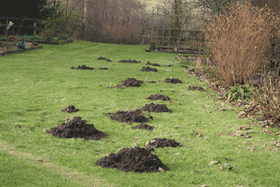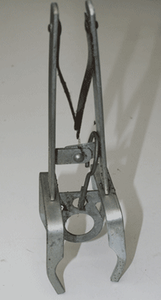Mole removal, get rid of moles

Addressing a mole issue can sometimes feel like the admission of a reforming alcoholic, with lines such as, "My name is Mr. Smith, and I have a mole problem." This phrase is a common refrain, not just from customers seeking professional assistance, but also from those eager to learn how to get rid of moles independently. Mastering efficient mole removal is a skill that has taken professional mole catchers years of practical study. Unless you're willing to invest substantial time in acquiring this expertise, the most practical solution is to enlist the services of a professional mole catcher. When contemplating the potential damage moles can cause and the subsequent repair costs, the fees charged by a moleman are remarkably economical.
Mole removal

Efficient and humane mole removal through the use of specialist traps requires the expertise of seasoned trappers. While sizeable scissor-type mole traps are available for purchase at garden centers and agricultural outlets, relying on them may result in catching the occasional mole. However, attempting to handle the situation independently could lead to a prolonged trail of damage, which a professional could have prevented. Most professional mole catchers can successfully capture moles within a few days of setting traps. Occasionally, it may take longer, especially if an inexperienced moleman attempts removal and inadvertently educates the mole to be more cautious.
Moles may not recognize traps, but they can be remarkably wary of anything new introduced into their runs. Considering that these dark tunnels constitute the mole's environment, with each twist, turn, side tunnel, wet patch, and potential meal location committed to memory, encountering an unfamiliar obstacle must be disconcerting, even for the boldest moles. An inexperienced operator may struggle to place traps correctly, leading to the mole sensing a problem and taking evasive action. In some cases, moles may be inadvertently caught and suffer a lingering death.
We often encounter gardens where well-intentioned DIY gardeners, eager to rid themselves of moles, inadvertently transform their landscape into a scene suitable for a documentary about the Battle of the Somme. In such instances, the cost of repairing the damaged area must be considered alongside the fee for a professional mole catcher to address the underlying problem.
Consider this: If faced with a pest like a squirrel chewing loft insulation, would you attempt to handle it yourself, or would you prefer a humane solution? Now, reflect on whether a mole's need for humane removal is any less significant than that of a squirrel.
If you find yourself needing to get rid of a mole without the knowledge of proper trapping techniques, we strongly recommend deferring to a professional mole catcher who can swiftly and humanely resolve the issue.
Why catch moles?
Public perspectives on pest species often undergo frequent shifts, with an increasing segment of the population adopting a strict no-kill policy toward animals. While some hold this stance as absolute and unwavering, everyone is entitled to their own opinions. For those who invest significant funds in maintaining a pristine lawn, the presence of a small nuisance wreaking havoc can be intolerable, and who can blame them?
Each mole, on average, creates 200 meters of tunnels through its digging activities, essential for its survival. The sheer damage caused by a single mole must be witnessed to be fully understood. While some may perceive moles as cute and harmless, they are, in reality, predatory creatures that fiercely defend their territory and exhibit cannibalistic tendencies.
In domestic settings, moles are deemed nuisances, causing aesthetic damage that can be financially burdensome. However, for farmers, the issue becomes more serious.
Consider the case of Listeriosis, a bacterial disease affecting sheep, cattle, and various other animals. How does this connect with moles? The Listeriosis bacteria resides in the soil brought to the surface as molehills. During silage making for winter livestock feed, farmers cut grass, and if molehills are present at this time, soil from these mounds can mix with the grass. Under conducive conditions, bacteria multiplication within the silage can lead to problems. Unfortunately, many sheep succumb to Listeriosis each year due to this bacterial contamination.

